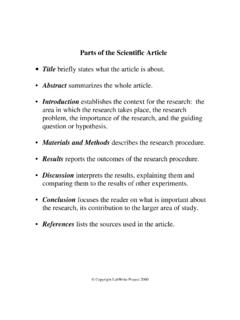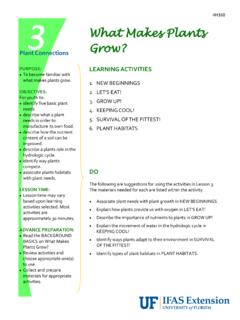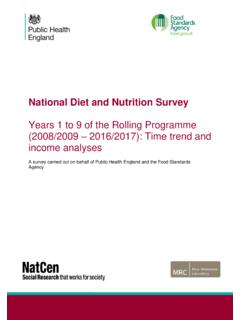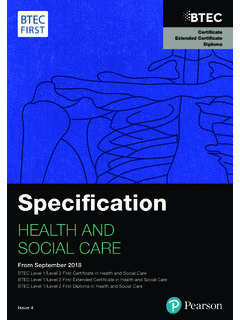Transcription of Determination of Specific Nutrients in Various Foods Abstract
1 Determination of Specific Nutrients in Various Foods Abstract Humans need to consume food compounds such as carbohydrates, proteins, fats, and vitamins to meet their energy requirements. In this lab, reagents were used as indicators to test common food substances for the presence of Specific Nutrients . Meat and eggs tested positively for protein, while fruit, cereal, bread and potatoes tested positively for starch and glucose. Meats and oils had a high fat content, and potato chips and frozen pizza had a high sodium content. None of the Foods tested in this lab would individually be able to meet all of our body s requirements for essential food compounds. Therefore, it is important to eat a variety of Foods that provide just the right balance between carbohydrates, proteins, and fat.
2 Introduction This lab focuses on the body s need for carbohydrates, proteins, and fats to obtain energy. The first law of thermodynamics states that energy cannot be created nor destroyed, but can change form. Humans must harvest a lot of the energy required for life from the chemical energy stored in food. Humans digest the food into simple compounds such as glucose, amino acids (protein), and fatty acids. Our cells break the compounds down further, releasing free energy which can be used for cellular work such as growth, muscle contraction, and tissue repair (Biological Science An Ecological Approach, 1992 & BSCS Biology A Molecular Approach, 2001). Carbon is the central element for all living things. Carbon atoms can combine with hydrogen, nitrogen, 2oxygen, sulfur, and phosphorus to form organic compounds.
3 Three basic types of organic compounds are found in all organisms: carbohydrates, lipids, and protein. Carbohydrates and lipids are important energy-storing compounds that contain carbon, hydrogen and oxygen. Simple sugar molecules, such as glucose, are broken down by chemical reactions in the cells during cellular respiration to release energy. Starch, a complex carbohydrate that is used for energy-storage in plants, is a good source of food for humans. Oils and fats are lipids, and gram per gram contain more than twice the amount of energy found in carbohydrates (Biological Science An Ecological Approach, 1992). This makes fat an excellent source of energy. Fat, however, contributes more than energy to the body. It is composed of fatty acids that can be saturated, monounsaturated, or polyunsaturated.
4 Both saturated and monounsaturated fatty acids can be synthesized by the human body and so are not necessary in the diet. In contrast, polyunsaturated fatty acids (PUFA s), referred to as essential fatty acids, are essential for life but cannot be synthesized by the human body. These PUFA s must be consumed in food. They are involved in many important processes such as regulating blood clotting, maintaining the membranes of cells, maintaining healthy cholesterol levels, and facilitating the absorption of fat-soluble vitamins (A, E, K, and D) from food. (The Vegan Society: Essential Fatty Acids, 2003). While carbohydrates and fats are important sources of energy, proteins play a very important role in the body as a basic building block for many physiological processes.
5 The subunit of a protein molecule is an amino acid, which is the basic unit of the genetic code. Composed of carbon, hydrogen, oxygen and nitrogen, amino acids 3combine to form simple or complex proteins that play important roles in building cellular structures and catalyzing reactions. Since animals cannot synthesize all of the amino acids, they must obtain some of them the essential amino acids from food (Biological Science An Ecological Approach, 1992). The main objective of this lab is to determine the chemical composition of Various food items. Adding Specific reagents to small amounts of common Foods and observing their reactions allows us to determine the presence of key Nutrients in the sample food: sugar , starch, protein, Vitamin C, chloride, and fat.
6 The purpose of this lab is to learn about the nutritional composition of Various Foods taken from the average American diet. Some of the questions that this lab will help answer include: (1) Does food coloring interfere with the nutritional analyses of select Foods through reagent testing? (2) Which food item has a proportional nutritional composition for all six food compounds? (3) Are Foods that show a proportional nutritional composition for all six food compounds the best sources of energy for the body? Methods Part A: Using Indicators to Determine Compounds Present in Foods In order to establish a baseline, five reagents were used to test for known nutrient compounds found in certain Foods . First, five test tubes were labeled (test tubes #1-5) with the first five food substances listed in Table 1.
7 Five mL of 10 % gelatin suspension followed by 10 drops of Biuret solution were added to test tube #1. Five mL of 10% glucose solution followed by 3 mL of Benedict s solution were added to test tube #2. Test tube #2 was then placed in a beaker of boiling water for five minutes and then 4allowed it to cool. It was necessary to heat the solution to boiling for the Benedict s solution to react by changing color. Five mL of 10 % starch solution and 5 drops of Lugol s iodine solution were added to test tube #3. Five mL of 1% ascorbic acid followed by 8 drops of indophenol were added to test tube #4. Five mL of NaCl solution followed by five drops of silver nitrate solution were added to test tube #5 to determine how many drops would be necessary to form a white precipitate.
8 The five reagents added to test tubes #1-5 were used to test for protein, simple sugars, starch, Vitamin C, and chloride (salt). Observations for test tubes were recorded based on a color index for a reagent or by the number of drops required to form precipitate (see Table 1). To test for fat, 1 mL of vegetable oil and teaspoon of butter were each rubbed on a piece of brown wrapping paper. The paper was held up to the light and rated according to its level of greasiness. Part B: Discovering Compounds in Common Foods The same reagents used in part A were used to test selected food items for the presence of protein, simple sugars, starch, fat, Vitamin C, and chloride. All Foods were chopped into small pieces and blended with water in a food processor until they were of paste consistency.
9 Ten test tubes were labeled with the name of each food item, and 5 mL of each food was placed in the corresponding test tubes. Reagents were added to each test tube as follows: 10 drops of Biuret solution, 3 mL of Benedict s solution (the test tube was heated and then cooled as described above), 5 drops of Lugol s iodine solution, 8 drops of indophenol, and 5 drops of silver nitrate solution. Observations were recorded for each test tube. 5 Finally, each food paste was rubbed on a brown wrapping paper in a test for fat. The paper was held up to the light to determine if the food left a grease smudge as described above. If no fat was detected the food was dissolved in a 99% isopropyl alcohol solution for five minutes. The solution was then poured on the brown paper and allowed to dry for ten minutes before observation.
10 6 Table 1. Reagent tests of known Nutrients for Specific food substances Food substance Reagent Nutrient Indicator Response Gelatin suspension Biuret solution Protein Light lavender (4) Glucose solution Benedict s solution sugar Bright yellow (3) Starch solution Lugol s iodine solution Starch Dark blue (4) Ascorbic acid solution Indophenol solution Vitamin C Colorless (5) NaCl solution Silver nitrate solution Chloride 3 drops* Butter None Fat Level 5 greasy spot** Vegetable oil None Fat Level 5 greasy spot** Note: Numbers in parentheses indicate the range of response for each reagent: Biuret solution: 1 = pink, 5 = purple; Benedict s solution: 1 = green, 3 = yellow, 5 = orange; Lugol s iodine solution: 1 = light blue, 5 = black; Indophenol solution: 1 = blue, 5 = colorless *Silver Nitrate solution: Number indicates the number of drops necessary to form a white precipitate in solution.






